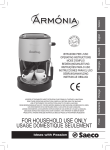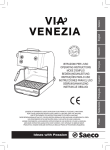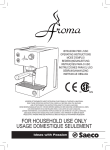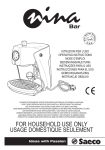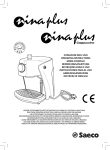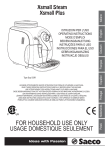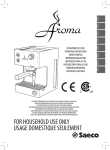Download Saeco Nina cappuccino Operating instructions
Transcript
ISTRUZIONI PER L'USO OPERATING INSTRUCTIONS MODE D’EMPLOI BEDIENUNGSANLEITUNG INSTRUÇÕES PARA O USO INSTRUCCIONES PARA EL USO GEBRUIKSAANWIJZING INSTRUKCJE OBSŁUGI LEGGERE ATTENTAMENTE QUESTE ISTRUZIONI D'USO PRIMA DI UTILIZZARE LA MACCHINA. READ THESE OPERATING INSTRUCTIONS CAREFULLY BEFORE USING THE MACHINE. LIRE ATTENTIVEMENT CES INSTRUCTIONS AVANT D’UTILISER LA MACHINE. DIESE BEDIENUNGSANLEITUNG IST VOR DEM ERSTEN GEBRAUCH DER MASCHINE AUFMERKSAM ZU LESEN. LER ATENTAMENTE ESTAS INSTRUÇÕES PARA O USO ANTES DE USAR A MÁQUINA. LÉANSE ATENTAMENTE LAS SIGUIENTES INSTRUCCIONES DE USO ANTES DE UTILIZAR LA MÁQUINA. LEES DEZE INSTRUCTIES AANDACHTIG DOOR VOORDAT U HET APPARAAT IN GEBRUIK NEEMT. PRZECZYTAĆ UWAŻNIE NINIEJSZE INSTRUKCJE OBSŁUGI PRZED UŻYTKOWANIEM URZĄDZENIA. Ideas with Passion 1 5 2 6 3 7 4 8 11 12 10 13 14 18 9 17 15 40 cm 16 in 16 20 cm 8 in 20 cm 8 in 20 cm 8 in 20 cm 8 in Fig.A - Abb.A - Afb.A - Rys.A •2• Fig.1 - Abb.1 - Afb.1 - Rys.1 Fig.2 - Abb.2 - Afb.2 - Rys.2 Fig.3 - Abb.3 - Afb.3 - Rys.3 Fig.4 - Abb.4 - Afb.4 - Rys.4 Fig.5 - Abb.5 - Afb.5 - Rys.5 Fig.6 - Abb.6 - Afb.6 - Rys.6 Fig.7 - Abb.7 - Afb.7 - Rys.7 Fig.8 - Abb.8 - Afb.8 - Rys.8 Fig.9 - Abb.9 - Afb.9 - Rys.9 Fig.10 - Abb.10 - Afb.10 - Rys.10 Fig.11 - Abb.11 - Afb.11 - Rys.11 Fig.12 - Abb.12 - Afb.12 - Rys.12 •3• Fig.13 - Abb.13 - Afb.13 - Rys.13 Fig.14 - Abb.14 - Afb.14 - Rys.14 Fig.15 - Abb.15 - Afb.15 - Rys.15 Fig.16 - Abb.16 - Afb.16 - Rys.16 Fig.17 - Abb.17 - Afb.17 - Rys.17 Fig.18 - Abb.18 - Afb.18 - Rys.18 Fig.19 - Abb.19 - Afb.19 - Rys.19 Fig.20 - Abb.20 - Afb.20 - Rys.20 Fig.21 - Abb.21 - Afb.21 - Rys.21 Fig.22 - Abb.22 - Afb.22 - Rys.22 Fig.23 - Abb.23 - Afb.23 - Rys.23 Fig.24 - Abb.24 - Afb.24 - Rys.24 •4• Fig.25 - Abb.25 - Afb.25 - Rys.25 Fig.26 - Abb.26 - Afb.26 - Rys.26 Fig.27 - Abb.27 - Afb.27 - Rys.27 Fig.28 - Abb.28 - Afb.28 - Rys.28 Fig.29 - Abb.29 - Afb.29 - Rys.29 Fig.30 - Abb.30 - Afb.30 - Rys.30 Fig.31 - Abb.31 - Afb.31 - Rys.31 Fig.32 - Abb.32 - Afb.32 - Rys.32 Fig.33 - Abb.33 - Afb.33 - Rys.33 Fig.34 - Abb.34 - Afb.34 - Rys.34 Fig.35 - Abb.35 - Afb.35 - Rys.35 Fig.36 - Abb.36 - Afb.36 - Rys.36 •5• 1 GENERAL INFORMATION The coffee machine is ideal for brewing 1 or 2 cups of espresso coffee and it is provided with a swivel steam and hot water spout. The controls on the front side of the machine are labelled with easy-to-read symbols. The machine has been designed for household use only. It is not suitable for professional, continuous use. Warning. No liability is held for damages caused by: • Improper and inconsistent use of the machine. • Repairs carried out by anyone other than authorized service centres. • Tampering with the power cord. • Tampering with any component of the machine. • Use of non-original spare parts and accessories. • Failed descaling and storage at temperatures below 0°C. In such cases, the warranty is not valid. 1.1 To Facilitate interpretation The warning triangle indicates the instructions that are important for user's safety. Please follow these instructions carefully to avoid serious injury! Illustrations, parts of the machine and control elements are referred to by numbers or letters; in this case please refer to the illustration. This symbol emphasizes particularly important information to take into greater account for a better use of the machine. The illustrations corresponding to the text can be found on the first pages of the manual. Please refer to this page while reading the operating instructions. 1.2 How to Use These Operating Instructions Keep these operating instructions in a safe place and make them available to anyone who may use the coffee machine. For further information or in case of problems, please refer to any authorized service centre. • 14 • 2 TECHNICAL SPECIFICATIONS The manufacturer reserves the right to make technical changes to the product. Nominal Voltage - Power rating - Power supply See label on the appliance Shell material Plastic Size (w x h x d) (mm) 270 x 350 x 300 Weight 4 kg Cord length 1.2 m Control panel Front side Portafilter Pressurized type Pannarello Special for cappuccinos Water Tank 1.5 litres - Removable type Pump pressure 15 bar Boiler Stainless steel Safety devices Thermal fuse 3 SAFETY REGULATIONS Do not put live parts in contact with water: Danger of short circuit! Overheated steam and hot water may cause scalding! Do not direct the steam or hot water jet towards body parts. Handle the steam/hot water spout with care: Danger of scalding! Intended Use The coffee machine is intended for domestic use only. Do not make any technical changes or use the machine for unlawful purposes since this would create serious hazards! The appliance is not for use by persons (included children) with reduced physical, mental or sensory abilities or with scarce experience and/or competences, unless they are supervised by a person responsible for their safety or they are instructed by him/her to use the machine. Connect the coffee machine only to a suitable socket. The voltage must correspond to the value shown on the machine’s label. Power Cord Do not use the coffee machine if the power cord is defective. If damaged, the power cord must be replaced by the manufacturer or its customer service centre. Do not run the cord around sharp corners and edges as well as on hot objects and keep it away from oil. Do not use the power cord to carry or pull the coffee machine. Do not unplug the machine by pulling the power cord or touch the plug with wet hands. Do not let the power cord hang freely from tables or shelves. Protecting Other People Prevent children from playing with the machine. Children are not aware of the risks stemming from household appliances. Do not leave the coffee machine packaging within the reach of children. Danger of Burns Do not direct the jet of overheated steam and/or hot water towards yourself or other people. Always use the special handles or knobs. Do not disconnect (remove) the pressurized portafilter during coffee brewing. Hot water drops may spill out of the coffee brew unit during the warming up. Location Place the coffee machine in a safe place, where nobody may overturn it or be injured. Hot water or overheated steam may spill out of the machine: Danger of scalding! Do not keep the machine at a temperature below 0°C; frost may damage the machine. Do not use the coffee machine outdoors. Do not place the machine on very hot surfaces and close to open flames in order to prevent its housing from melting or being damaged. Cleaning Before cleaning the machine, disconnect it by pressing the ON/OFF button, then pull out the plug from the socket. Wait for the machine to cool down. Do not immerse the machine in water! It is strictly forbidden to tamper with the internal parts of the machine. Water left in the tank for several days should not be consumed. Wash the tank and fill it with fresh drinking water. within easy reach. • Allow for a minimum distance from the sides of the machine as shown in Fig. A. Storing the Machine If the machine is to remain unused for a long time, turn it off and unplug it from the socket. Keep it in a dry place out of children’s reach. Shelter it from dust and dirt. Repairing / Maintenance In case of failure, faults or a suspected fault after dropping, remove the plug from the socket immediately. Do not operate a faulty machine. Servicing and repairing should be carried out by authorized service centres only. All liability for damages caused by works not carried out in a professional manner is declined. Fire Safety In case of fire, use carbon dioxide (CO2) extinguishers. Do not use water or dry powder extinguishers. Key to machine components (Page 2) 1 2 3 4 5 6 7 8 9 10 11 Control panel ON/OFF button Water Tank Hot water/steam knob Drip tray & grill Coffee brew unit Steam spout (Pannarello) Power cord Ground coffee measuring scoop Pressurized portafilter Ground coffee filter (single piece for 1 or 2 coffee(s)) Ground coffee filter adapter Brewing pin Coffee pod filter Coffee/Water light - "Machine ready" Steam ready light Selection knob Cappuccinatore (optional) 12 13 14 15 16 17 18 4 INSTALLATION For your and other people safety, follow the "Safety Regulations" in section 3 carefully. 4.1 Packaging The original packaging has been designed to protect the machine during transport. We recommend keeping the packaging for future transport. Space for Operation and Maintenance To ensure that the coffee machine works properly and efficiently, read the following instructions. • Choose an even surface. • Choose an adequately lit and clean location with a socket 4.2 Installation Instructions Before installing the machine, read the following safety instructions carefully. • Put the machine in a safe place. • Make sure children cannot play with the machine. • 15 • English Power Supply • Do not place the machine on hot surfaces or near open flames. The coffee machine is now ready to be connected to the power supply. Note: It is recommended to wash the components before using them for the first time and/or after they have not been used for a certain period of time. 4.3 Machine Connection Electric power can be dangerous! It is therefore essential to follow the safety regulations carefully. Do not use faulty cords! Faulty cords and plugs must be immediately replaced by authorized service centres. Appliance voltage has been pre-set by the manufacturer. Make sure that the power voltage matches the indications on the identification plate on the bottom of the appliance. • Make sure that the ON/OFF button (2) is not pressed before connecting the machine to the power supply. • Fit the plug into a wall socket with suitable power voltage. 4.4 Water Tank • (Fig.1) - Remove the water tank (3). • (Fig.2) - Rinse the water tank and fill it with fresh drinking water taking care not to overfill it. • (Fig.1) - Insert the water tank making sure that it has properly been replaced in its former seat. Use only fresh, non-sparkling drinking water to fill the tank. Hot water, as well as any other liquid, may damage the tank. Do not turn on the machine with empty water tank: make sure there is enough water in the tank. 4.5 Circuit Priming Before starting the machine after a long period of inactivity and after ejecting steam, the machine circuit needs to be primed. • (Fig.3) - Press the ON/OFF button (2). • (Fig.4) - Place a container under the steam spout. • (Fig.5) - Open the "hot water/steam" knob (4) by turning it anticlockwise. " position • (Fig.6) - Switch the selection knob to the " (17). • Wait until a steady jet of water flows out of the steam spout (Pannarello). • (Fig.6) - Switch the selection knob to the " "position (17). • Close the "hot water/steam" knob (4) by turning it clockwise. Remove the container. The machine is now ready to operate. Please see the related sections for coffee brewing operating details. • 16 • 4.6 Drip Tray Adjustment The drip tray can be adjusted according to the cup size. To adjust the drip tray height, do as follows. • (Fig.24) - Lift the drip tray and remove the grill. • (Fig.25) - Remove the support under the drip tray. • (Fig.26 - 27) - Rotate the support and place it in the coffee machine. • (Fig.28) - Put the drip tray on the support and replace the grill. 5 COFFEE BREWING Warning! During the coffee brewing, do not remove the pressurized portafilter by manually turning it clockwise. Danger of burns. • During this operation, the "machine ready" light (15) may flash; this is to be considered a standard and not a faulty operating mode. • Before using the machine, make sure that the hot water/ steam knob (4) is closed and that there is enough water in the tank. • (Fig.3) - Press the ON/OFF button (2). • Wait until the "machine ready" light (15) turns on. The machine is now ready for coffee brewing. 5.1 Using Ground Coffee • (Fig.7) - Insert the pin (13) into the pressurized portafilter (10). • (Fig.8A) - Insert the adapter (12) into the pressurized portafilter (10), then insert the filter (11). • (Fig.11) - Insert the portafilter into the brew unit from the bottom (6). • (Fig.12) - Turn the portafilter from left to right until it locks in place. • (Fig. 14) - Preheat the pressurized portafilter by switching the selection knob (17) to the " " position until some water spills out of it. This is to be done only for the first coffee brewing. • When 50cc of water have flowed out, switch the selection knob (17) to the " " position in order to stop brewing. • (Fig.16) - Remove the portafilter from the machine by turning it from right to left and drain any water left. There is no need to change the filter to make one or two coffees, since the machine is equipped with a special filter (11). • (Fig.9A) - Add 1- 1.5 measuring scoop for single coffee and 2 measuring scoops for double coffee. Remove any coffee residues from the rim of the filter. • (Fig.11) - Insert the portafilter (10) into the brew unit from the bottom (6). • (Fig.12) - Turn the portafilter from left to right until it locks in place. • (Fig.13) - Take 1 or 2 preheated cups and place them under the pressurized portafilter. Make sure that they are correctly placed under the coffee dispensing holes. • (Fig.14) - Turn the selection knob (17) to the " " position. Note: If a small quantity of water remains in the portafilter; this is absolutely normal and is due to the portafilter features. Note for cleaning: Keep the filter of the pressurized portafilter clean by removing it from its seat and washing it with drinking water (Fig. 17). Wash the adapter and the pin of the portafilter, then wash the portafilter itself. 5.2 6 TIPS FOR CHOOSING COFFEE As a general rule any type of coffee available on the market can be used. However, coffee is a natural product and its flavour changes according to its origin and blend; it is therefore a good idea to try different types of coffee in order to find the most suited to your personal taste. For optimal results, however, we recommend using espresso machine blends. As a rule, Coffee should always come out of the portafilter without any dripping. The speed of coffee dispensing can be modified by slightly changing the amount of coffee in the filter and/or by using a different coffee grind. Saeco recommends using single-dose coffee pods marked ESE for a tasty coffee and easier cleaning and preparing. Using Coffee Pods • (Fig.10) - By using a coffee spoon, remove the ground coffee filter (11) and the adapter (12) from the pressurized portafilter (10). • (Fig.7) - Remove the pin (13) from the pressurized portafilter (10). • (Fig.9B) - Insert the pod filter (14) into the pressurized portafilter (10). • (Fig.11) - Insert the portafilter into the brew unit from the bottom (6). • (Fig.12) - Turn the portafilter from left to right until it locks in place. • (Fig. 14) - Preheat the pressurized portafilter by switching " position until some the selection knob (17) to the " water spills out of it. This is to be done only for the first coffee brewing. • When 50cc of water have flowed out, switch the selection knob (17) to the " " position in order to stop hot water dispensing. • (Fig.16) - Remove the pressurized portafilter from the machine by turning it from right to left. Be careful not to remove the filter. • (Fig.9B) - Insert the pod into the portafilter and make sure the paper of the pod does not overhang the portafilter. • (Fig.11) - Insert the portafilter into the brew unit from the bottom (6). • (Fig.12) - Turn the portafilter from left to right until it locks in place. • Take 1 preheated cup and place it under the portafilter; make sure that it is correctly placed under the coffee dispensing holes. • (Fig.14) - Turn the selection knob (17) to the " " position. • When the desired quantity of coffee has been obtained, turn the selection knob (17) to the " " position in order to stop coffee brewing, then remove the coffee cup. • (Fig.16) - Wait a few seconds after brewing, then remove the portafilter and dispose of the used pod. Note for cleaning: Keep the filter of the pressurized portafilter clean by removing it from its seat and washing it with drinking water (Fig. 17). Then wash the portafilter. BEFORE USING THE HOT WATER/STEAM JET, MAKE SURE THAT THE STEAM SPOUT (PANNARELLO) IS POSITIONED OVER THE DRIP TRAY. 7 HOT WATER Danger of scalding! When brewing starts, spurts of hot water may come out. The spout can reach high temperatures: do not touch it with bare hands. • (Fig.3) - Press the ON/OFF button (2). • Wait until the "machine ready" light (15) turns on. The machine is now ready. • (Fig.18) - Place a container or a teacup under the steam spout (Pannarello). • (Fig.5) - Open the knob (4). " position • (Fig.6) - Switch the selection knob to the " (17). • When the desired quantity of hot water has been dispensed, set the selection knob (17) to the " " position. • (Fig.5) - Close the knob (4). • Remove the container with hot water. 8 STEAM / CAPPUCCINO Danger of scalding! When brewing starts, spurts of hot water may come out. The spout can reach high temperatures: do not touch it with bare hands. • (Fig.3) - Press the ON/OFF button (2). • Wait until the "machine ready" (15) light turns on. • (Fig.19) - Switch the selection knob (17) to the " " position. • Wait until the light (16) turns on. The machine is now ready • 17 • English • When the desired quantity of coffee has been obtained, turn the selection knob (17) to the " " position in order to stop coffee brewing. Wait a few second after brewing has stopped, then remove the cups of coffee (Fig. 15). • (Fig.16) - Remove the pressurized portafilter and empty the remaining coffee residues. for steam ejection. • (Fig.18) - Place a container under the steam spout. • (Fig.5) - Open the knob (4) for a few seconds, so that remaining water flows out of the steam spout (Pannarello). In a short time only steam will come out. • Close the knob (4) and remove the container. • Fill 1/3 of the container you wish to use to prepare your cappuccino with cold milk. Use cold milk to get a better result. • (Fig.20) - Immerse the steam spout in the milk and open the knob (4) by turning it anticlockwise. Turn the milk container with slow upward movements so that it warms up evenly. • • • A maximum steam brewing of 60 seconds is recommended. • When brewing ends, close the knob (4) and remove the cup with the frothed milk. • (Fig.19) - Switch the selection knob (17) to the " " position. If both lights are on and the machine has reached a too high temperature to brew coffee, prime the circuit as described in section 4.5 to make the machine ready for use. Note: The machine is ready when the "machine ready" light (15) is permanently on. Note: If brewing a cappuccino as described is not possible, prime the circuit as explained in Section.5, then repeat the procedure. The same procedure can be used to heat other beverages. • After this operation, clean the steam spout with a wet cloth. 9 CLEANING Maintenance and cleaning may only be carried out when the machine has cooled down and has been disconnected from the power supply. • Do not immerse the machine in water nor place any of its parts in a dishwasher. • Do not use spirit, solvents and/or aggressive chemical agents. • We recommend cleaning the water tank and filling it up with fresh water daily. • (Fig.21-22) - Every day, after heating the milk, remove the external part of the Pannarello and wash it with fresh drinking water. • (Fig.23) - Clean the steam spout weekly. In order to do this, please: - Remove the external part of the Pannarello (for standard • 18 • • cleaning). - Loosen the ring nut (without removing it). - Remove the upper part of the Pannarello from the steam spout. - Wash the upper part of the Pannarello with fresh drinking water. - Wash the steam spout with a wet cloth and remove any milk residue. - Replace the upper part of the steam spout (make sure it is completely inserted). - Tighten the previously loosened ring nut. Reassemble the external part of the Pannarello. (Fig.24) - Empty and clean the drip tray daily Use a damp and soft cloth to clean the appliance. (Fig.17) - To clean the pressurized portafilter do as follows: - Remove the filter, wash it thoroughly with hot water. - Remove the adapter (if fitted), wash it thoroughly with hot water. - Remove the pin, wash it thoroughly with hot water. - Wash the internal part of the pressurized portafilter. Do not dry the machine and/or its components in a microwave and/or in a conventional oven. Note: do not wash the pressurized portafilter in the dishwasher. 10 DESCALING The formation of limescale inside the appliance is inevitable. It is necessary to descale the machine every 3-4 months of use and/or when you notice a reduction in the water delivery. If you want to descale the machine yourself, you can use a non-toxic and/or non-harmful descaling product for coffee machines (commercially available). We recommend using Saeco descaling solution. Warning! Do not use vinegar as a descaling solution. • (Fig.1) - Remove and empty the water tank. • (Fig.2) - Mix the descaling solution with water as specified on the descaling solution box and fill the water tank. Fit the tank into the machine. • (Fig.3) - Turn on the machine by pressing the ON/OFF button (2). • (Fig.4) - Place a container under the steam spout. • (Fig.5 - 6) To remove at intervals (one cup at a time) all the descaling solution: open the knob (4) and switch the selection knob (17) to the " " position. To stop brewing, switch the selection knob (17) to the " " position and close the knob (4). • (Fig.3) - During each interval disconnect the machine by pressing the ON/OFF button (2) in order to let the descaling solution take effect for about 10-15 minutes. Empty the container. • (Fig.1 - 2) - When the descaling solution is finished, remove the water tank, rinse it and fill it with fresh drinking water. • (Fig.1) - Reinsert the tank into the machine. • (Fig.4) - Place a container under the steam spout. • (Fig.5 - 6) - Open the knob (4) and set the selection knob (17) to the " " position to empty 2/3 of the water. To stop brewing switch the selection knob (17) to the " " position and close the knob (4). • Let the machine warm up and empty the water tank as described above. Wash the cappuccinatore as follows: If you are using a product other than the recommended one it is however important to follow the manufacturer’s instructions shown on the descaling solution box. After washing the components of the cappuccinatore, place it back on the coupling located on the machine. 11 CAPPUCCINATORE (OPTIONAL) Not all machine models are provided with cappuccinatore. The cappuccinatore allows you to easily and quickly prepare delicious cappuccinos. Follow these simple instructions to install it. 1 (Fig.29) - Loosen the ring nut on the upper part of the cappuccinatore. 2 Insert the cappuccinatore completely into the steam spout. 3 (Fig.30) - Tighten the ring nut. To use the cappuccinatore, prepare the machine as described in the related sections. Before using the accessories, we recommend washing them with water (Fig.31-32), immerse the suction pipe in a fresh water container and eject a small quantity of steam (please refer to the related instructions). In this way, the accessories will be perfectly clean before use. To clean the cappuccinatore, suck up clean water to clean the suction pipe. • (Fig.35) - Remove the extremity of the cappuccinatore from its seat. • Separate the cappuccinatore’s components. • (Fig.36) - Wash the cappuccinatore extremity with lukewarm water. Make sure no dirt is left inside. 11 DISPOSAL • Put unused appliances out of service. • Disconnect the plug from the socket and cut the electrical cord. • At the end of its life, take the appliance to a suitable waste collection site. This product complies with EU Directive 2002/96/EC. The symbol on the product or on its packaging indicates that this product may not be treated as household waste. Instead it shall be handed over to the applicable collection point for the recycling of electrical and electronic equipment. By ensuring this product is disposed of correctly, you will help prevent potential negative consequences for the environment and human health, which could otherwise be caused by inappropriate waste handling of this product. For more detailed information about recycling of this product, please contact your local city office, your household waste disposal service or the shop where you purchased the product. While the machine is getting ready, prepare a special container with milk or use the milk container. Place it beside the machine. • (Fig.33) - Immerse the suction pipe in the prepared milk. • (Fig.34) - Eject steam as described in section 8. Turn the pin to modify the milk froth. Lift the pin gently to obtain more froth. • After preparing the cappuccino, immerse the suction pipe into a container with fresh clean water and eject steam. The cappuccinatore is clean when clean water is dispensed. Clean the suction pipe externally with a damp cloth. The cappuccinatore must be removed and completely washed once a week. • 19 • English Warning. Do not use steam when the extremity of the cappuccinatore is not inserted into its seat. Fault Possible cause Solution The machine does not turn on. Machine not connected to the power supply. Connect the machine to the power supply. The pump is very noisy. No water in the tank. Refill with water. (section 4.4). The “machine ready” light (15) was off while switching the selection knob (17) to the " " position. Wait until the “machine ready” light (15) turns on. The portafilter is not inserted for preheating (section 5). Preheat the portafilter. Cold cups. Preheat the cups with hot water. Not suitable milk: powdered milk, low-fat milk. Use whole milk. Dirty Pannarello. Clean the Pannarello as described in section 9. No steam in the boiler. Prime the circuit (section 4.5) and repeat the operations described in section 8. Too little coffee in the portafilter. Add coffee (section 5). Coffee ground is too coarse. Use a different blend (section 6). Coffee is old or not suitable. Use a different blend (section 6). Old or not suitable pod. Change the pod. One component missing in the portafilter. Make sure that all components are present and that they have been installed properly. No water. Refill with water. (section 4.4). The coffee is too cold. Milk does not froth. It is not possible to prepare a cappuccino. The coffee is dispensed too fast, no foam builds up. Coffee is not dispensed or dispensed only in drips. Coffee drips from the edges. The grind is too fine. Use a different blend (section 6). Coffee pressed in the portafilter. Shake the ground coffee. Too much coffee in the portafilter. Reduce the quantity of coffee in the portafilter. Knob (4) is open. Close the knob (4). Traces of limestone. Descale the machine (section 10). The filter in the portafilter is clogged. Clean the filter (Section 9). Not suitable pod. Change type of pod. The portafilter is incorrectly inserted into the brew unit. Insert the portafilter correctly (Section 5). The upper edge of the portafilter is dirty. Clean the rim of the portafilter. Pod wrongly inserted. Insert the pod correctly. Make sure it does not come out of the portafilter. Too much coffee in the portafilter. Reduce the quantity of coffee using the measuring scoop. Please contact an authorized service centre for any faults not covered in the above table or when the suggested solutions do not solve the problem. • 20 • DICHIARAZIONE DI CONFORMITA' CE EC 2006/95, EC 2004/108, EC 1992/31, EC 1993/68 Noi : EC DECLARATION OF CONFORMITY EC 2006/95, EC 2004/118, EC 1992/31, EC 1993/68 We : Saeco International Group Via Torretta , 240 40041 GAGGIO MONTANO (BO) dichiariamo sotto la nostra responsabilità che il prodotto : MACCHINA PER CAFFE' SINGOLA TIPO : SIN 026X al quale si riferisce questa dichiarazione è conforme alle seguenti norme : • Sicurezza di elettrodomestici e apparecchi elettrici - Requisiti generali EN 60335-1 (2002) + A1(2004) + A2(2006) + A11(2004) + A12 (2006) • Sicurezza di elettrodomestici e apparecchi elettrici - Parte 2-15 - Requisiti specifici per apparecchi per riscaldare liquidi - EN 60 335-2-15 (2002) + A1(2005) • Sicurezza apparecchi per uso domestico e similare. Campi elettromagnetici - Metodi per la valutazione e le misure EN 50366 (2003) + A1 (2006). • Limiti e metodi di misurazione dei disturbi radio caratteristici di apparecchi con motore elettrico e termici per uso domestico e simili scopi, strumenti elettrici e simili apparecchiature elettriche - EN 55014-1 (2000) + A1 (2001) + A2 (2002) • Compatibilità elettromagnetica (EMC) Parte 3^ Limiti - Sezione 2 : Limiti per le emissioni di corrente armonica (corrente in ingresso dell'apparecchiatura ≤ 16A per fase) - EN 61000-3-2 (2000) • Compatibilità elettromagnetica (EMC) - Parte 3^ Limiti - Sezione 3 : Limitazione delle fluttuazioni e dei picchi di tensione nei sistemi di alimentazione a bassa tensione per apparecchiature con corrente nominale ≤ 16A. EN 61000-3-3 (1995) + A1(2001) • Requisiti di immunità per elettrodomestici, strumenti e apparecchi similari. Norma per famiglia di prodotti EN 55014-2 (1997) + A1 (2001) secondo le disposizioni delle direttive : CE 73/23, CE 89/336, CE 92/31, CE 93/68. Saeco International Group Via Torretta , 240 40041 GAGGIO MONTANO (BO) declare under our responsibility that the product : COFFEE MAKER TYpe : SIN 026X to which this declaration relates is in conformity with the following standards or other normative documents : • Safety of household and electrical appliances - General requirements - EN 60335-1(2002 ) + A1(2004) + A2(2006) + A11(2004) + A12(2006) • Safety of household and electrical appliances - Part 2-15 - Particular requirements for appliances for heating liquids - EN 60335-2-15(2002) + A1(2005) • Household and similar electrical appliances - Electromagnetic fields - methods for evaluation and measurement EN 50366 (2003) + A1 (2006). • Electromagnetic compatibility (EMC) - Requirements for household appliances , electric tools and similar apparatus - Part 1 Emission EN 55014-1 (2000) + A1 (2001) + A2 (2002). • Electromagnetic compatibility (EMC) - Part. 3^ Limits - Section 2 : Limits for harmonic current emissions (equipment input current ≤ 16A for phase) - EN 61000-3-2 (2000) • Electromagnetic compatibility (EMC) Part 3^ : Limits - Section 3 : Limitation of voltage changes , voltage fluctuations and flicker in public low - voltage supply systems , for equipment with rated current ≤ 16 A for phase and not subject to conditional connection EN 61000-3-3 (1995) + A1 (2001) • Electromagnetic compatibility - Requirements for household appliances , electric tools and similar apparatus - Part 2. Immunity - Product family standard EN 55014-2 (1997) + A1 (2001) following the provisions of the Directives : EC 73/23, EC 89/336, EC 92/31, EC 93/68. Gaggio Montano 05/07/2006 Gaggio Montano 05/07/2006 R&D Ing. Andrea Castellani KONFORMITÄTSERKLÄRUNG CE 2006/95/EG, 2004/108/EG, 1992/31/EG, 1993/68/EG Wir: DÉCLARATION CE DE CONFORMITÉ CE 2006/95, CE 2004/108, CE 1992/31, CE 1993/68 Nous : Saeco International Group Via Torretta , 240 40041 GAGGIO MONTANO (BO) erklären unter eigener Verantwortung, dass das Produkt: EINZELKAFFEEMASCHINE TYP : SIN 026X auf das sich diese Erklärung bezieht, folgenden Normen entspricht: • Sicherheit elektrischer Geräte für den Hausgebrauch und ähnliche Zwecke - Allgemeine Anforderungen EN 60335-1 (2002) + A1(2004) + A2(2006) + A11(2004) + A12 (2006) • Sicherheit elektrischer Geräte für den Hausgebrauch und ähnliche Zwecke - Teil 2-15 Besondere Anforderungen für Geräte zur Flüssigkeitserhitzung - EN 60 335-2-15 (2002) + A1(2005) • Sicherheit Geräte für den Hausgebrauch und ähnliche Zwecke. Elektromagnetische Felder Verfahren für die Bewertung und die Messungen EN 50366 (2003) + A1 (2006). • Grenzwerte und Messverfahren für Funkstörungen von Geräten mit elektromotorischem - Antrieb und Elektrowärmegeräten für den Hausgebrauch und ähnliche Zwecke, Elektrowerkzeugen und ähnlichen Elektrogeräten EN 55014-1 (2000) + A1 (2001) + A2 (2002) • Elektromagnetische Verträglichkeit (EMV) Teil 3 Grenzwerte - Abschnitt 2: Grenzwerte für Oberschwingungsströme (Geräte-Eingangsstrom ≤ 16A je Leiter) - EN 61000-3-2 (2000) • Elektromagnetische Verträglichkeit (EMV) Teil 3 Grenzwerte - Abschnitt 3: Grenzwerte für Spannungsschwankungen und Flicker in Niederspannungsnetzen für Geräte mit einem Eingangsstrom ≤ 16A. EN 61000-3-3 (1995) + A1(2001) • Störfestigkeit von Haushaltsgeräten, Elektrowerkzeugen und ähnlichen Geräten. Produktfamiliennorm EN 55014-2 (1997) + A1 (2001) gemäß den Bestimmungen der Richtlinien: 73/23/EG, 89/336/EG, 92/31EG, 93/68/EG. Gaggio Montano 05/07/2006 Saeco International Group Via Torretta , 240 40041 GAGGIO MONTANO (BO) déclarons sous notre responsabilité que le produit : MACHINE À CAFÉ TYPE : SIN 026X auquel se réfère cette déclaration est conforme aux normes suivantes : • Sécurité d'appareils électroménagers et électriques Prescriptions générales - EN 60335-1 (2002) + A1(2004) + A2(2006) + A11(2004) + A12 (2006) • Sécurité d'appareils électroménagers et électriques - Partie 2-15. Prescriptions particulières pour les appareils de chauffage des liquides - EN 60 335-2-15 (2002) + A1(2005) • Sécurité des appareils pour usage domestique et analogue. Champs électromagnétiques - Méthodes pour l'évaluation et les mesures EN 50366 (2003) + A1 (2006). • Limites et méthodes de mesure des perturbations radio produites par les appareils électroménagers ou analogues comportant des moteurs électriques ou des dispositifs thermiques, par les outils électriques et par les appareils électriques analogues EN 55014-1 (2000) + A1 (2001) + A2 (2002) • Compatibilité électromagnétique (CEM) Partie 3 Limites - Section 2 : Limites pour les émissions de courant harmonique (courant appelé par les appareils ≤ 16A par phase) - EN 61000-3-2 (2000) • Compatibilité électromagnétique (CEM) Partie 3 Limites - Section 3 : Limitation des variations et des fluctuations de tension et du papillotement dans les réseaux d'alimentation basse tension pour appareils ayant un courant nominal ≤ 16A. EN 61000-3-3 (1995) + A1(2001) • Prescriptions d'immunité pour les appareils électroménagers, outils électriques et appareils analogues. Norme de famille de produits EN 55014-2 (1997) + A1 (2001) conformément aux dispositions des directives : CE 73/23, CE 89/336, CE 92/31, CE 93/68. Gaggio Montano 05/07/2006 R&D Ing. Andrea Castellani DECLARACIÓN DE CONFORMIDAD CE 2006/95 CE, 2004/108 CE, 1992/31 CE, 1993/68 CE Nosotros, la empresa : DECLARAÇÃO DE CONFORMIDADE CE CE 2006/95, CE 2004/108, CE 1992/31, CE 1993/68 Nós : Saeco International Group Via Torretta , 240 40041 GAGGIO MONTANO (BO) Saeco International Group Via Torretta , 240 40041 GAGGIO MONTANO (BO) declaramos bajo nuestra responsabilidad que el producto : declaramos sob nossa inteira responsabilidade que o produto : MÁQUINA DE CAFÉ TIPO : SIN 026X MÁQUINA DE CAFÉ TIPO : SIN 026X al cual se refiere esta declaración, cumple con las siguientes normas : a que se refere esta declaração está conforme com as seguintes normas : • Seguridad de los aparatos electrodomésticos y análogos - Requisitos generales - EN 60335-1 (2002) + A1(2004) + A2(2006) + A11(2004) + A12 (2006) • Seguridad de los aparatos electrodomésticos y análogos - Parte 2-15 - Requisitos particulares para aparatos para calentar líquidos - EN 60 335-2-15 (2002) + A1(2005) • Seguridad de los aparatos electrodomésticos y análogos. Campos electromagnéticos. Técnicas de ensayo y de medida EN 50366 (2003) + A1 (2006). • Límites y métodos de medida de las características relativas a la perturbación radioeléctrica de los aparatos electrodomésticos o análogos accionados por motor o con dispositivos térmicos, de las herramientas y equipos eléctricos análogos - EN 55014-1 (2000) + A1 (2001) + A2 (2002) • Compatibilidad electromagnética (CEM) Parte 3^ Límites - Sección 2 : Límites para las emisiones de corriente armónica (equipos con corriente de entrada ≤ 16 A por fase) - EN 61000-3-2 (2000) • Compatibilidad electromagnética (CEM) Parte 3^ Límites - Sección 3 : Limitación de las fluctuaciones de tensión y del flicker en redes de baja tensión para los equipos con corriente de entrada ≤ 16 A. EN 61000-3-3 (1995) + A1(2001) • Requisitos para los aparatos electrodomésticos, herramientas eléctricas y aparatos análogos. Inmunidad. Norma de familia de productos EN 55014-2 (1997) + A1 (2001) • Segurança de aparelhos electrodomésticos e análogos - Parte 1: Regras gerais - EN 60335-1 (2002) + A1(2004) + A2(2006) + A11(2004) + A12 (2006) • Segurança de aparelhos electrodomésticos e análogos - Parte 2-15 - Regras particulares para aparelhos de aquecimento de líquidos - EN 60 335-2-15 (2002) + A1(2005) • Aparelhos electrodomésticos e análogos. Campos electromagnéticos Métodos para avaliação e medição EN 50366 (2003) + A1 (2006). • Requisitos para electrodomésticos, ferramentas eléctricas e dispositivos similares - Parte 1: Emissão Norma de família de produto - EN 55014-1 (2000) + A1 (2001) + A2 (2002) • Compatibilidade electromagnética (CEM) Parte 3^ Limites - Secção 2 : Limites para emissões de corrente harmónicas (corrente de entrada do equipamento até 16A, inclusive, por fase) - EN 61000-3-2 (2000) • Compatibilidade electromagnética (CEM) Parte 3^ Limites - Secção 3 : Limitação das flutuações de tensão e tremulação em sistemas de alimentação de baixa tensão para equipamentos de corrente nominal até 16 A, inclusive. EN 61000-3-3 (1995) + A1(2001) • Requisitos para aparelhos electrodomésticos, ferramentas portáteis e aparelhos eléctricos análogos . Norma de família de produto EN 55014-2 (1997) + A1 (2001) conforme a lo establecido en las directivas : 73/23 CE, 89/336 CE, 92/31 CE, 93/68 CE. segundo as disposições das directivas : CE 73/23, CE 89/336, CE 92/31, CE 93/68. Gaggio Montano 05/07/2006 Gaggio Montano 05/07/2006 R&D Ing. Andrea Castellani EG CONFORMITEITSVERKLARING EG 2006/95, EG 2004/108, EG 1992/31, EG 1993/68 DEKLARACJA ZGODNOŚCI WE 2006/95 WE, 2004/108 WE, 1992/31 WE, 1993/68 WE My: Wij : Saeco International Group Via Torretta , 240 40041 GAGGIO MONTANO (BO) verklaren onder eigen verantwoordelijkheid dat het product: ENKELVOUDIGE KOFFIEMACHINE Type : SIN 026X waarnaar deze verklaring verwijst, voldoet aan de volgende normen: • Huishoudelijke en soortgelijke elektrische toestellen - Veiligheid - Algemene eisen - EN 60335-1 (2002) + A1(2004) + A2(2006) + A11(2004) + A12 (2006) • Huishoudelijke en soortgelijke elektrische toestellen Veiligheid - Deel 2-15 - Bijzondere eisen voor toestellen voor verwarming van vloeistoffen EN 60 335-2-15 (2002) + A1(2005) • Veiligheid voor huishoudelijke en soortgelijke toestellen. Elektromagnetische velden. - Methoden voor evaluatie en meting EN 50366 (2003) + A1 (2006). • Elektromagnetische compatibiliteit - Eisen voor huishoudelijke toestellen, elektrisch gereedschap en soortgelijke apparaten - Deel 1 Emissie - EN 55014-1 (2000) + A1 (2001) + A2 (2002) • Elektromagnetische compatibiliteit (EMC) Deel 3-2 : Limietwaarden - Limietwaarden voor de emissie vanharmonische stromen (ingangsstroom van de toestellen 16 A per fase) - EN 61000-3-2 (2000) • Elektromagnetische compatibiliteit (EMC) Deel 3-3 : Limietwaarden - Limietwaarden voor spanningswisselingen, spanningsschommelingen en flikkering in openbare laagspanningsnetten voor apparatuur met een ingangsstroom 16 A per fase en zonder voorwaardelijke aansluiting EN 61000-3-3 (1995) + A1(2001) • Elektromagnetische compatibiliteit - Eisen voor huishoudelijke toestellen, elektrisch gereedschap en soortgelijke apparaten - Deel 2: Immuniteit - Productgroepnorm EN 55014-2 (1997) + A1 (2001) volgens de bepalingen van de richtlijnen: EG 73/23, EG 89/336, EG 92/31, EG 93/68. Gaggio Montano 05/07/2006 Saeco International Group Via Torretta , 240 40041 GAGGIO MONTANO (BO) niniejszym deklarujemy, ponosząc za to pełną odpowiedzialność, że produkt: EKSPRES DO KAWY POJEDYNCZY TYP : SIN 026X do którego odnosi się ta deklaracja jest zgodny z wymaganiami zawartymi w następujących normatywach: • Zasady bezpieczeństwa dla sprzętu domowego i elektrycznego - Wymagania ogólne - EN 60335-1 (2002) + A1(2004) + A2(2006) + A11(2004) + A12 (2006) • Zasady bezpieczeństwa dla sprzętu domowego i elektrycznego - Część 2-15 - Wymagania szczególne dla urządzeń służących do ogrzewania płynów EN 60 335-2-15 (2002) + A1(2005) • Zasady bezpieczeństwa przyrządów do użytku domowego i podobnego. Pola elektromagnetyczne Metody oceny i pomiaru EN 50366 (2003) + A1 (2006). • Dopuszczalne poziomy i metody pomiarów zakłóceń radioeletrycznych wytwarzanych przez urządzenia o silniku elektrycznym lub termiczne do użytku domowego lub do podobnych celów i przez przyrządy i sprzęty elektryczne - EN 55014-1 (2000) + A1 (2001) + A2 (2002) • Kompatybiliność elektromagnetyczna (EMC) Część 3^ Dopuszczalny poziom - Rozdział 2: Dopuszczalne poziomy emisji harmonicznych prądu (prądu wejściowego ≤ 16A na fazę) - EN 61000-3-2 (2000) • Kompatybiliność elektromagnetyczna (EMC) Część 3^ Dopuszczalny poziom - Rozdział 3: Dopuszczalne zmiany i wahania napięcia w systemach zasilania niskim napięciem dla urządzeń o prądzie nominalnym ≤ 16A. - EN 61000-3-3 (1995) + A1(2001) • Wymagania dotyczące odporności sprzętu domowego, przyrządów i podobnej aparatury. Normatywa dla grupy produktów EN 55014-2 (1997) + A1 (2001) zgodnie z rozporządzeniami zawartymi w dyrektywach: WE 73/23, WE 89/336, WE 92/31, WE 93/68. Gaggio Montano 05/07/2006 R&D Ing. Andrea Castellani Type Sin026X Cod. 15001190 Rev.00 15-07-07 Saeco International Group S.p.A. Via Torretta, 240 - 40041 Gaggio Montano Bologna - Italy - Tel. +39 0534.771.111 - Fax. +39 0534.31025 http://www.saeco.com



















